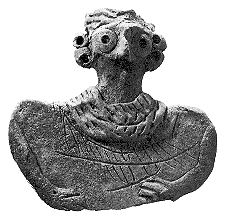INTRODUCTION
 The excavations at Sweyhat, Syria, are jointly sponsored by The Oriental Institute and the University Museum, the University of Pennsylvania. Co-directors of the project are Thomas Holland, Ph.D., Oriental Institute Research Associate and Richard Zettler, Associate Professor at the University of Pennsylvania. The project was initiated by Holland under the sponsorship of the Ashmolean Museum, Oxford University; three excavation seasons wre conducted in 1973-75. The project resumed under Pennsylvania sponsorship in 1989 and has continued under joint Pennsylvania-Chicago sponsorship to the present, with field seasons in 1991, 92, and 93. A seventh season is planed for 1994.
The excavations at Sweyhat, Syria, are jointly sponsored by The Oriental Institute and the University Museum, the University of Pennsylvania. Co-directors of the project are Thomas Holland, Ph.D., Oriental Institute Research Associate and Richard Zettler, Associate Professor at the University of Pennsylvania. The project was initiated by Holland under the sponsorship of the Ashmolean Museum, Oxford University; three excavation seasons wre conducted in 1973-75. The project resumed under Pennsylvania sponsorship in 1989 and has continued under joint Pennsylvania-Chicago sponsorship to the present, with field seasons in 1991, 92, and 93. A seventh season is planed for 1994.
Sweyhat is a small Bronze Age city on the east bank of the Euphrates river, tucked into a small embayment formed by steep bluffs rising up to the Syrian desert. Research objectives at Sweyhat are focused on both the city and the region. Excavations and magnetometer surveys within the city are focused on town planning and the spatial organization of administrative, craft production, and domestic activities. The regional study, conducted by Tony Wilkinson, a specialist in archaeological gemorphology and agriculture, is designed to investigate agricultural adaptation to a marginal environment. The recent discovery of a beautiful small figurine of a domestic horse was reported in the New York Times and received wide media coverage, particularly in specialized equestrian publications.

